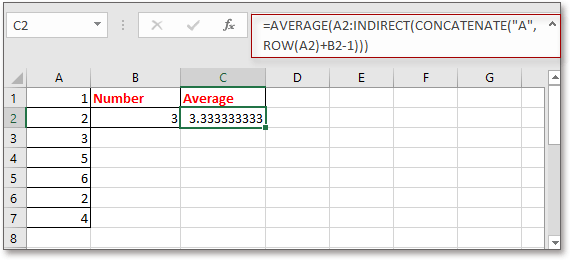كيفية تحديد النطاق بناءً على قيمة خلية أخرى في Excel؟
حساب نطاق من القيم أمر سهل بالنسبة لمعظم مستخدمي Excel، ولكن هل سبق لك أن حاولت حساب نطاق من القيم بناءً على الرقم الموجود في خلية معينة؟ على سبيل المثال، يوجد عمود من القيم في العمود A، وأريد حساب عدد القيم في العمود A بناءً على القيمة الموجودة في الخلية B2، مما يعني أنه إذا كانت القيمة 4 في الخلية B2، فسوف أحسب متوسط أول 4 قيم في العمود A كما هو موضح في لقطة الشاشة أدناه. الآن سأقدم صيغة بسيطة لتحديد النطاق بسرعة بناءً على قيمة خلية أخرى في Excel.
تحديد النطاق بناءً على قيمة الخلية
 تحديد النطاق بناءً على قيمة الخلية
تحديد النطاق بناءً على قيمة الخلية
لإجراء الحساب لنطاق بناءً على قيمة خلية أخرى، يمكنك استخدام صيغة بسيطة.
حدد خلية فارغة حيث ستضع النتيجة، وأدخل هذه الصيغة =AVERAGE(A1:INDIRECT(CONCATENATE("A",B2)))، واضغط Enter للحصول على النتيجة.
1. في الصيغة، A1 هي الخلية الأولى في العمود الذي تريد حسابه، A هو العمود الذي تقوم بالحساب له، B2 هي الخلية التي تعتمد عليها في الحساب. يمكنك تغيير هذه المراجع حسب الحاجة.
2. إذا كنت تريد إجراء عملية جمع، يمكنك استخدام هذه الصيغة =SUM(A1:INDIRECT(CONCATENATE("A",B2))).
3. إذا كانت أول بيانات تريد تحديدها ليست في الصف الأول في Excel، على سبيل المثال، في الخلية A2، يمكنك استخدام الصيغة التالية: =AVERAGE(A2:INDIRECT(CONCATENATE("A",ROW(A2)+B2-1))).
العد/المجموع السريع للخلايا حسب اللون الخلفي أو تنسيق اللون في Excel |
في بعض الحالات، قد يكون لديك نطاق من الخلايا بألوان متعددة، وما تريده هو العد/المجموع للقيم بناءً على نفس اللون، فكيف يمكنك الحساب بسرعة؟ مع Kutools لـ Excel'sالعد بواسطة اللون، يمكنك القيام بالعديد من العمليات الحسابية حسب اللون بسرعة، كما يمكنك أيضًا إنشاء تقرير عن النتيجة المحسوبة. قم بتنزيل Kutools وجرّبه اليوم! |
Kutools لـ Excel - قم بتعزيز Excel بأكثر من 300 أدوات أساسية. استمتع بميزات ذكاء اصطناعي مجانية بشكل دائم! احصل عليه الآن |
أفضل أدوات الإنتاجية لمكتب العمل
عزز مهاراتك في Excel باستخدام Kutools لـ Excel، واختبر كفاءة غير مسبوقة. Kutools لـ Excel يوفر أكثر من300 ميزة متقدمة لزيادة الإنتاجية وتوفير وقت الحفظ. انقر هنا للحصول على الميزة الأكثر أهمية بالنسبة لك...
Office Tab يجلب واجهة التبويب إلى Office ويجعل عملك أسهل بكثير
- تفعيل تحرير وقراءة عبر التبويبات في Word، Excel، PowerPoint، Publisher، Access، Visio وProject.
- افتح وأنشئ عدة مستندات في تبويبات جديدة في نفس النافذة، بدلاً من نوافذ مستقلة.
- يزيد إنتاجيتك بنسبة50%، ويقلل مئات النقرات اليومية من الفأرة!
جميع إضافات Kutools. مثبت واحد
حزمة Kutools for Office تجمع بين إضافات Excel وWord وOutlook وPowerPoint إضافة إلى Office Tab Pro، وهي مثالية للفرق التي تعمل عبر تطبيقات Office.
- حزمة الكل في واحد — إضافات Excel وWord وOutlook وPowerPoint + Office Tab Pro
- مثبّت واحد، ترخيص واحد — إعداد في دقائق (جاهز لـ MSI)
- الأداء الأفضل معًا — إنتاجية مُبسطة عبر تطبيقات Office
- تجربة كاملة لمدة30 يومًا — بدون تسجيل، بدون بطاقة ائتمان
- قيمة رائعة — وفر مقارنة بشراء الإضافات بشكل منفرد